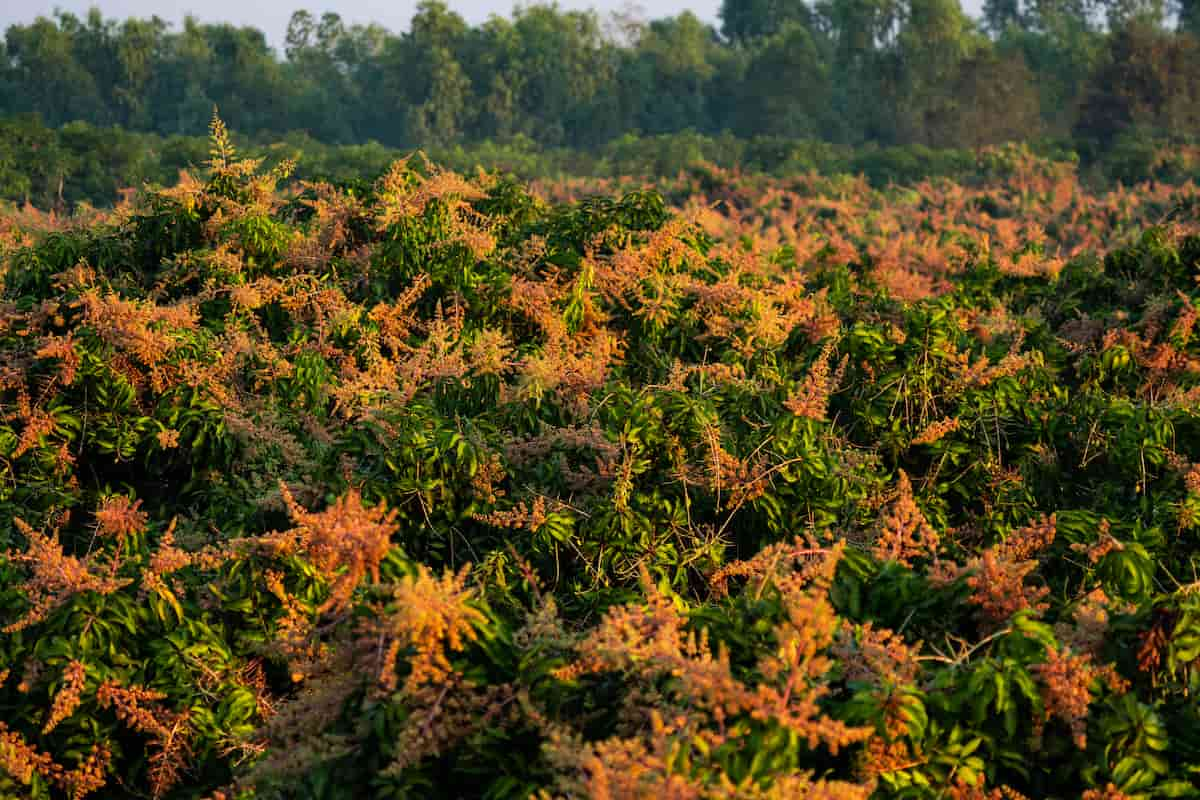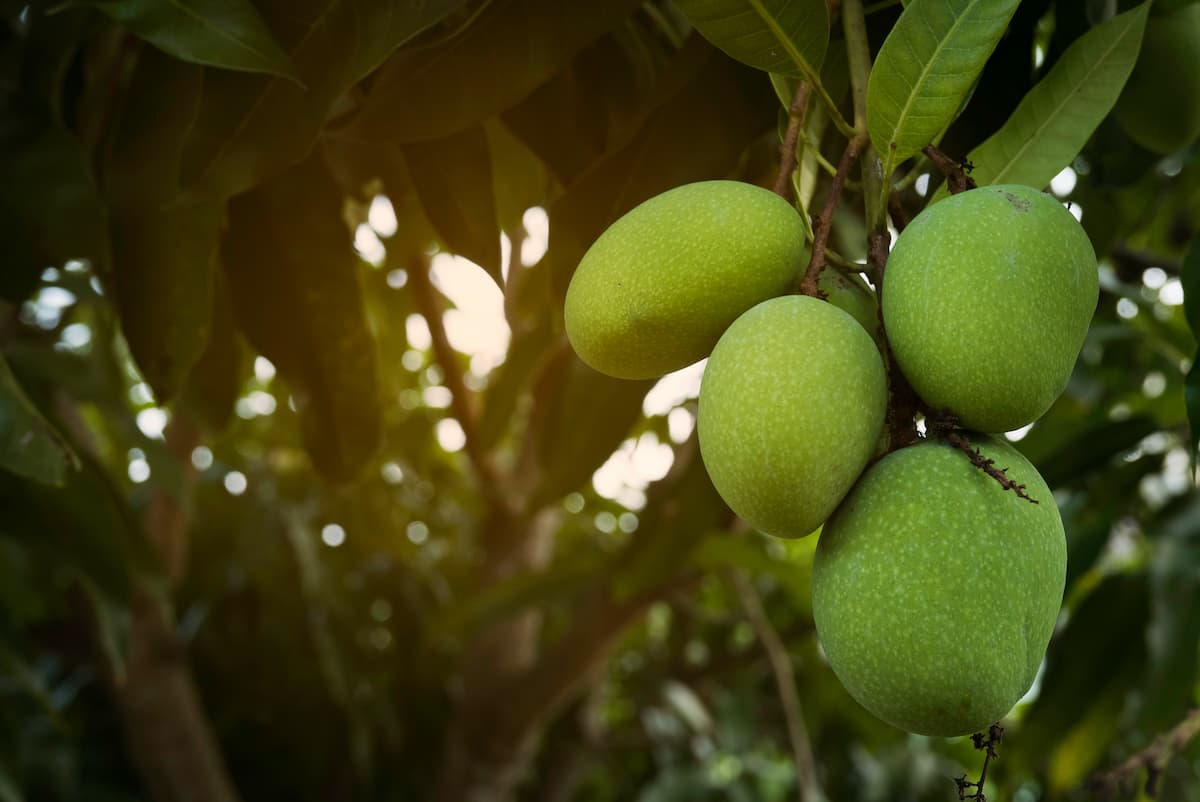Mango Alternate Bearing or Biennial Bearing or Irregular Bearing is a complex physiological disorder affecting mango crops’ productivity and profitability. Mango alternate bearing is a physiological disorder that affects mango crops, causing them to produce uneven fruit yields over time. Managing alternate bearing in mango crops is a significant challenge for farmers, as there are no clear-cut solutions to the problem.

Strategies proposed to mitigate the effects of alternate bearing include cultural practices, such as pruning and thinning, plant growth regulators, and other chemical treatments. However, these methods have mixed success rates, and their effectiveness may depend on the specific conditions of the orchard and the variety of mango grown. Understanding the underlying causes of alternate bearing and developing effective management strategies are essential for sustaining mango production and ensuring the long-term viability of this important crop.
Mango Alternate Bearing and Clustering Disorders Management
Characteristics of Mango Alternate Bearing Disorder
- This phenomenon is characterized by a pattern in which trees heavily bear fruits in one year (on year), followed by a smaller or non-existent harvest the following year (off year).
- This cycle can continue for several years, leading to economic losses for mango farmers and a decrease in the quality of the fruit produced.
- This disorder is often observed in varieties with axillary fruit-bearing habits compared to the ones with terminal fruit-bearing habits.
Causes of Mango Alternate Bearing Disorder Development
- The cause of mango alternate bearing disorder is not entirely understood, but it is believed to be a combination of factors related to tree physiology, genetics, and environmental conditions.
- Some of the known factors that can contribute to alternate bearing include inadequate nutrition, water stress, disease, and pest infestations.
- The heavier consumption of essential nutrients like carbon, hydrogen, oxygen, and nitrogen reserves in the ‘on year’ will reduce crop production in the ‘off year’ as they are crucial for the fruit bud initiation phase.
- Axillary fruit-bearing varieties often develop this disorder due to higher crop load on the tree.
- A lower female-to-male gender ratio increases crop load in the ‘on year.’
- The trees affected by pests and diseases will be more susceptible to this disorder.
Favorable Conditions of Mango Alternate Bearing Disorder
- Rain, high humidity, and low-temperature result in the development of this disorder.
- A prolonged drought or waterlogging can cause stress to mango trees, resulting in a lower yield in the subsequent season.
- An extended period of cold or frost can damage the flowers, reducing the fruit set and ultimately leading to a lower yield.
- Lack of essential nutrients, such as nitrogen, phosphorus, and potassium, can affect the development and maturation of mango fruit, leading to a lower yield in the following season.
- Higher quantities of auxins, inhibitor substances, and lower quantities of gibberellins are crucial for a flowering shoot.
In case you missed it: Mango Gummosis Disease Management: Symptoms, Treatment, Chemical, Biological, Natural, and Organic Control

Management Measures of Mango Alternate Bearing Disorder
- Use regular bearing cultivars.
- Proper maintenance of the crop orchard.
- Practice de-blossoming the orchard in the ‘on year’ to prevent excessive fruit crop production.
- The girdling & ringing technique in the bark can be followed in the ‘on year’ to hamper the excess nutrient uptake and transport.
- The smudging technique uses a plant growth regulator called ethylene along with traces of urea to force the blooming of the mango trees in the ‘off year.’
- Maintaining a high C/N ratio in the orchard can help the crops in the fruit bud initiation phase during the ‘off year.’
- Perform soil drenching with the chemical Paclobutrazol to induce flowering in the mango orchards.
Mango Clustering or Jhumka
Mango clustering is a physiological disorder that affects mango crops and results in fruit clusters on the tree. Mango clustering can significantly impact the quality and yield of the mango crop, leading to economic losses for mango farmers. Managing mango clustering is a significant challenge for mango farmers, as there are no definitive solutions to the problem.
So, it is essential to understand the causes and risk factors associated with MCD and to develop effective management strategies to prevent or minimize the disorder’s impact on mango production. This article provides an overview of the Mango Clustering Disorder, including its symptoms, causes, and management strategies, to aid in the development of effective control measures and improve mango production.
Characteristics of Mango Clustering Disorder
- This phenomenon is characterized by the production of many small pea or marble-sized fruits grouped in a tight cluster at the tip of the panicle resembling a bunchy tip appearance known as jhumka.
- The shape of these fruits resembles that of the unfertilized ones.
- The fruits that develop this disorder are dark green.
- The growth of these fruits occurs up to marble size and then ceases.
- These fruits remain on the panicles without growing and drop down after one month from the fruit setting stage.
Causes of Mango Clustering Disorder Development
- The disorder is often associated with mango varieties with a genetic predisposition to produce small-sized fruits.
- Inadequate pollination or Failure of pollination due to insufficient pollinators, severe weather conditions, and flower structure will cause this disorder.
- The absence of adequate pollinating agents in the orchards is conducive to the disorder development.
- The new flush of foliage often competes with the developing fruits for photosynthesis.
Favorable Conditions of Mango Clustering Disorder
- High humidity levels can promote the growth of fungi, which can affect the flowers’ development, leading to incomplete pollination and the formation of clustered fruits.
- Improper pruning and thinning practices can result in excessive vegetative growth, forming clustered fruits and reducing fruit production.
- Adverse climates, especially low temperatures during February and March, can lead to clustering disorders.
- Irregular use of pesticides at the flowering stage can develop this disorder.
- Hormonal balances and various environmental factors, such as temperature, light, and water availability, will influence flower and fruit development and maturation on mango trees.
In case you missed it: Mango Scab Disease Management: Symptoms, Treatment, Chemical, Biological, and Organic Control

Management Measures of Mango Clustering Disorder
- Use NAA sprays to induce inflorescence development in October and November.
- Avoid spraying any insecticides at the flowering stage.
- Place Jaggery in the orchards to attract the pollinating agents in the blooming stage.
- Integrating Commercial Bee-keeping hives along with mango production can suffice the need for pollinators and ensure pollination.
- Deworming Schedule for Dogs/Puppies: A Beginners Guide
- How to Prevent and Control Parasites in Goats
- Beneficial Insects in Pest Management
- Natural Solutions for Pest Control in Flower Gardens
- Types of Fungicides Used in Agriculture
- Common Issues in the Fruit Development Stage of Pomegranate Farming
- Fruit Development Issues in Papaya: Easy Solutions and Treatment
- Soil-Borne Diseases and How to Protect Your Plants
- Practices to Prevent Disease Spread in the Garden